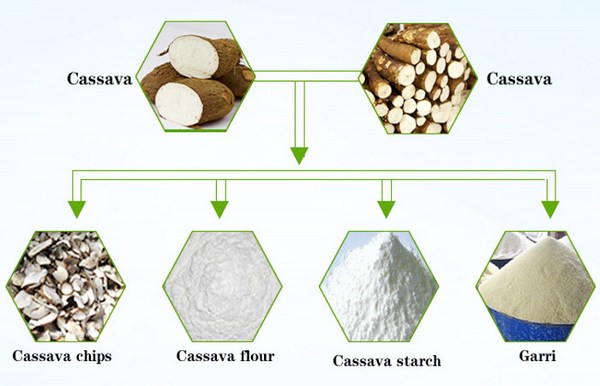What can we do with the byproducts during cassava processing?
FAQ / Chat online / Technical support / June 18, 2019
1. Cassava products for animal feeding
Cassava byproducts have long been used for animal feeding. Large quantities of cassava roots and cassava waste are utilized in the cassava-producing countries for this purpose. Imports of dried cassava roots and meal into European markets for the supply of the compound feed industry are also increasing.
Chips
This is the most common form in which dried cassava roots are marketed and most exporting countries produce them. The chips are dried irregular slices of roots which vary in size but should not exceed 5 cm in length, so that they can be stored in silos. They are produced extensively in Thailand, Malaysia, Indonesia and some parts of Africa.
Processing for chips
The present method of processing chips in Thailand, Malaysia and some other countries is very simple, consisting in mechanically slicing the cassava roots and then sun drying the slices. The recovery rate of chips from roots is about 20-40 percent. However, the products are considered inferior in quality by some quality-conscious feedstuff manufacturers, although many others consider them satisfactory.
 Cassava products
Cassava products
When the roots are not sorted, peeled and washed, the chips are usually brown in colour and have a high content of fibre sand and foreign objects as well as hydrocyanic acid. Trimming, peeling and washing the roots in a similar manner as for the processing of cassava flour are recommended in order to produce white chips of superior quality.
Slicing or shredding
The roots are shredded in a special machine, which is usually made locally. The machine consists of a rotating notched cutting disk or knife blades mounted on a wooden frame equipped with a hopper as shown in Figure 31. The cassava roots are cut into thin slices and pieces as they pass through the machine.
Drying
Sun drying is used mostly where the sliced roots are spread out on drying areas, or concrete floors of various dimensions. Experiments in Madagascar showed that the concentration of chips during drying should not exceed 10-15 kg/m2, the required drying area space being about 250 m2 for each ton per day of dried roots produced.
Broken roots
Similar to chips in appearance, but generally thicker and longer, they are often 12-15 cm long and can jam the mechanism of handling equipment. They are produced mainly in Africa where local processors prefer to produce longer roots because of the domestic demand mainly for products suitable for human consumption, as cassava is part of the staple diet. Once processed into chips the product becomes inedible, and the producer wants to conserve the local market.
Pellets
The pellets are obtained from dried and broken roots by grinding and hardening into a cylindrical shape. The cylinders are about 2-3 cm long and about 0.4-0.8 cm in diameter and are uniform in appearance and texture.
Meal for animals
2. Dried yeast
Microbial protein is attracting growing interest owing to the enormous protein requirements of the world. Among the microorganisms which are considered possible food sources, yeast has perhaps stirred the greatest interest. Candida and saccharomyces yeasts have had a well-established place for many years as feed, and the technology of production, the composition and the nutritive value of yeast are well known.
Most of the production of yeast is based on such low-cost raw materials as waste liquids, wood hydrolyzates and molasses. Starch-rich plant materials from wastes or surplus production are also utilized as substrata for yeast production. Cassava starch and cassava roots are being used in Malaysia and some other countries for the production of yeasts for animal feed' the human diet and for bakery yeast. The starch is hydrolyzed into simple sugars (predominantly glucose) by means of mineral acid or by enzymes. Certain yeasts are then propagated which assimilate the simple sugars and produce microbial cellular substances. The dry, inactive yeast contains about 7 percent moisture and the raw protein content can vary between 40 and 50 percent depending on the raw material.
The yield of yeast production also depends on the raw material. In some applications of cassava starch conversion into substances obtained from yeasts, a 38-42 percent yield of yeast product containing 50 percent raw protein has been obtained.
contact us
- Do you want to buy machine?
- Yes, I want to buy machine
- No, I want to learn more in advance.
- What is your raw material?
- Cassava
- Potato
- Sweet potato
- Others
- 2. What is the final product you want to produce?
- Garri
- Cassava flour
- Cassava starch
- Cassava chips
- Attiekie
- Bammy
- Others
- 3.What is your capacity plan?
- Small scale garri machine
- 1ton per day
- 2tons per day
- 3tons per day
- 10tons per day
- 20tons per day
- Others
- 3.What is your capacity plan?
- Small scale
- 5tons per day
- 10tons per day
- 20tons per day
- 50tons per day
- 100tons per day
- Others
- 3.What is your capacity plan?
- Small scale
- 5tons per day
- 10tons per day
- 20tons per day
- 50tons per day
- 100tons per day
- 200tons per day
- 300tons per day
- Others
- 3.What is your capacity plan?
- Small scale
- Middle type
- Large scale
- What is your capacity plan?
- Small scale
- 5tons per day
- 10tons per day
- 20tons per day
- 50tons per day
- 100tons per day
- 200tons per day
- 300tons per day
- Others

 Call us
Call us Chat online
Chat online
